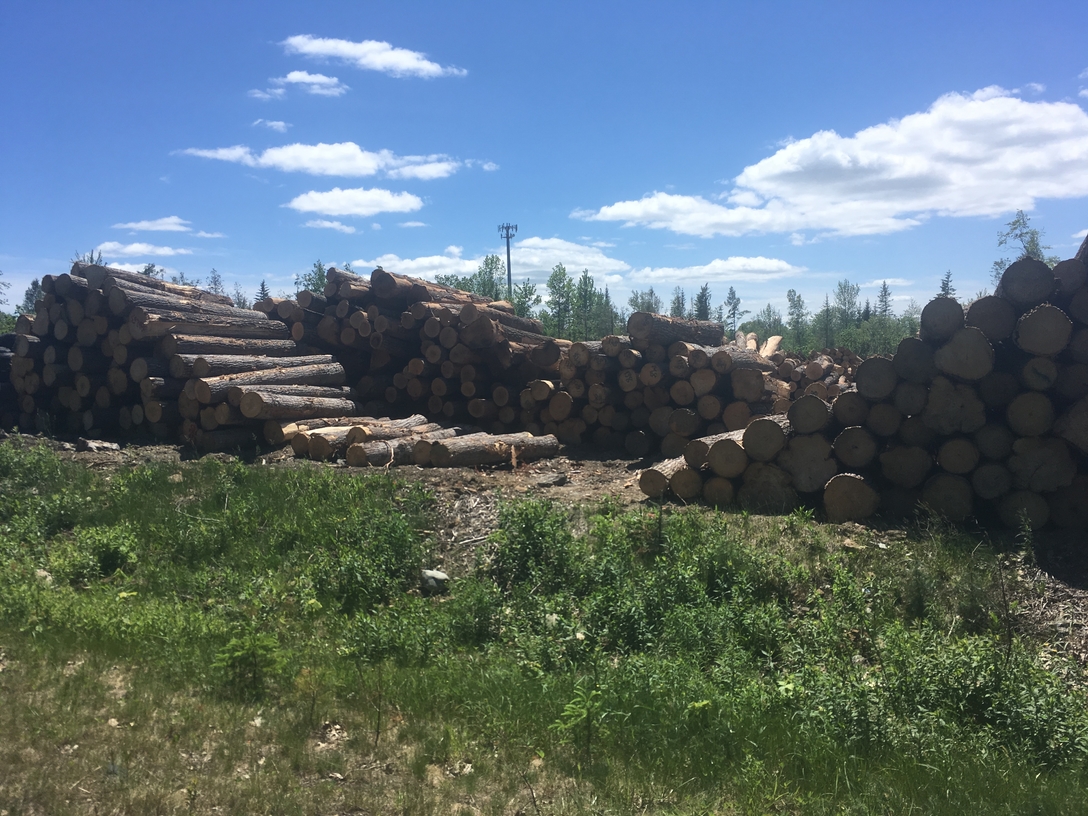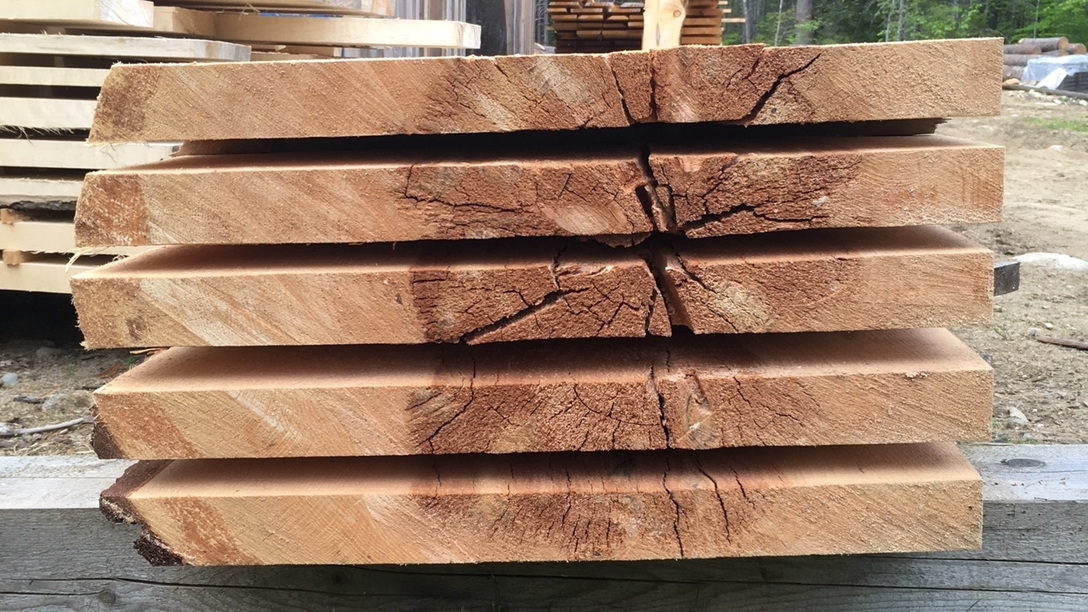On a Monday morning in mid-April, it took longer than expected to leave the house for my daughter’s first day of camp, which coincided with her school’s spring break. Overnight, freezing rain left a sheet of pebbled ice draped over the car. The crocuses were up, the daffodils budding, a wintry mix was in the forecast. Sometimes, Prince sang, it snows in April; sometimes, you have to scrape the windshield. Around here, in rural Maine, they call this third winter—or fourth, depending on who is counting.
I’m writing this in front of the fire, where it’s warmer than the 63 degrees Fahrenheit the thermostat registered when I first woke up. We heat the front of our house—living and dining room, kitchen—predominantly with the woodstove, and the oil-burning furnace keeps the back bedrooms comfortable. I used to be fairly confident in my ability to make a fire, which my grandpa taught me to do in the woodstove he used to heat his farmhouse in Iowa. But if nothing else, my first full winter of building fires out of necessity rather than for ambiance has made it clear that being able to set a bunch of sticks alight is just one part of heating a house with wood.
There were plenty of hindrances to keeping a warm house. The persistent downdraft, the time the chimney cap was sealed shut with a crown of shimmering creosote, like a pipe clogged with resin or tar. The running out of wood, the hours spent hacking up trees only to find they were either too green or too rotted to burn. The flush of stress-sweat sparked by watching the living room back up with smoke on a subzero night when I stupidly let the oil tank run dry. We may live our lives in and around wood—with timber framing buildings and house, finished boards creaking underfoot, and chips and scraps and pulp refashioned into Ikea furniture—and yet outside of a city, wood is a more apparent part of the rhythm of rural life. The cozy comfort of a crackling fire—and the very necessary warmth it generates—is a rhythm that feels to me more like a wave: either you catch it and ride it out through winter, or, if your timing is off, it crashes over you.
At the very least, I have become better at simply starting a fire this winter. The trick, in our house at least, is to start by opening a window, which, after hours of reading message-board threads about more-serious reasons (with invasive, expensive solutions to match) why the wind likes to funnel down our chimney instead of being drawn up it, I finally tried out. In a relatively airtight house, which ours apparently is, letting the cold outside air pour in pushes the warm inside air up the chimney—along with the smoke that the few crumples of paper give off after I set a match to them. It doesn’t take long for the shards of red-cedar shingles used for kindling to catch, and then increasingly larger bits of wood can be fed into the firebox, followed by larger splits that, with the damper closed, can heat the house for hours.
There’s a million short-lived seasons in Maine, defined by everything from tiny nuisances like black flies to whatever it is you’re allowed to kill in the woods at a particular time of year. Being “from away,” I find it hard to keep track of what’s what, but these seasons give me a different way of appreciating the fine texture and detail of a changing landscape, and highlight small bits of wonder—like the red cast maple buds take on before their catkins bloom, a harbinger of spring that stands out in sharp contrast against the ice-glazed April ground.
A guy named Dan dropped off a half cord of locust on our lawn in early December, concluding what had for weeks been a fruitless search for firewood on Craigslist and various local Facebook groups. (Firewood-buying is a season in Maine too, and I was late to the game.) With thick, shaggy brown bark and grain the color of straw, it looked far different from the stacks of white ash we burnt during the milder spring and fall, when fires were more a comfort than a necessity. With its dense, tight grain, locust is similar to oak (often considered the best species of wood for heating a home), each log like a massive bundle of BTUs that will dissipate over the course of hours. Locust doesn’t burn hot and fast like birch, or spit and crackle like poplar—which, as Dan told me knowingly, is called poplar for a reason.

Mounded up on the front lawn, the half cord looked like an impressive amount of wood. But when my neighbor Kevin came by the house a few days later, he asked if I had found firewood for the winter. Gesturing to the porch, where I had by then neatly stacked the logs, I told him about the locust. He assured me that he had seen the logs—he was worried that they wouldn’t be enough. By mid-January, after a stretch of weeks when the temperature rarely tipped above zero, we had nearly burned through it all, and it was back to Craigslist—and into the woods behind our house—to find more. It hasn’t taken long to see the wood in our small stand of woods—scattered with fallen poplar, lengths of birch snapped off by the wind, and standing stems of dead red oak—not as trees in various states of decay but as 18-inch lengths of potential fuel, to learn which boughs sound dry enough to burn, under the rap of my knuckles or the strike of an axe. I bought a bigger axe, a better handsaw; I borrowed a too-tiny electric chainsaw. I concluded that Pa Ingalls from the Little House books must have been swole.
Even if it’s not that big around, a tree that’s 20 or more feet high looms overhead—even when you’re out in the woods, surrounded by trees, by wood. And chopping through a trunk that’s a foot or so around at its thickest, each blow of the axe at once sending chips flying and resulting in little apparent progress, can make cutting down even a small tree feel like a sizable task. After it’s felled and sheared of branches, each cut taking it further away from tree-ness and closer to utility, the few logs, each six or seven feet long, stop looking like an imposing tree and start looking more like a week or so’s worth of firewood.
Maine has not only taught me to consider trees in terms of BTUs. Maine also lays bare the physical process by which trees become product. Here is a tall white pine standing in the woods; here, its trunk, branches sawed off, drying out atop numerous others in someone’s front yard; here, a section milled to board thickness, like a fat baguette cut end to end. Restacked with spacers between the layers, the sliced log looks like a book-ready diagram of where flooring and paneling and shelving and bar tops come from.
In a state where all but about 10 percent of land remains covered in trees—the most heavily forested state in the nation—wood isn’t simply industry, a resource extracted from the landscape. Wood is culture, the foundation of identity. Mainers will buck and split a log to burn, dry and mill a trunk for lumber, carve a burl or branch into a bowl or spoon. Birch is steamed into the bent hull of a canoe, and larch is curled into the arc of a snowshoe. In the origin myth of the Wabanaki federation, whose tribes inhabited the woods of New England for millennia, the first humans spilled out of a hole in a black ash—a tree that can be pounded into slats and woven into baskets.
There is today as much forested land in the state as there was when the first colonist arrived (although Maine’s oldest trees date only from the early 1800s). The growth of timberland is the product not of an industry in decline, but one that has come to better understand the need for conservation and replanting. The woods expanded in Maine because the timber industry needs them to be there. But while the industry tries to spin wood as a sustainable material, the reality is not so simple here in Maine, or in working woods around the world. Across the globe, 18.7 million acres of land are deforested annually—outpacing both the rate of natural regrowth and deliberate efforts to plant new trees. Still, increased environmental protections and the adoption of better management practices across the timber industry have caused the global rate of deforestation to drop significantly in recent decades.
It’s a marvel that sawdust and woodchips can be compressed into boards strong enough to frame a mattress for . . . for at least a few years. But when wood is atomized into its myriad components—broken down even into a product as simple as a bundle of firewood—it is divorced from its origins. When dust and chips and heat and pressure make the materials we live our lives in, on, and around, they appear as just that—materials, not the byproduct of so much fallen timber. Truly, we cannot see the forest for the trees.

Talking about home-heating solutions is an extension of how people talk about the weather in Maine, where it is horribly cold for much of the year. The sights and sounds of home heating are a near constant: the wisps and whirls and puffs of woodsmoke rising above rooftops, the crack and thud of wood being split and stacked. For the dedicated, this is more than just fall and winter (and spring) work—burning wood is a year-round affair, with green trees cut in late winter, when the moisture content is the lowest, the wood left to dry out over the warm(er) months to come. I met a Mainer once who had not only two wood stoves but a wood-fired furnace too, and he pulled something like four or five cords of wood off of his 19-acre woodlot every year. When asked if he had a log splitter—which puts the labor of making round logs stove-ready on a large piston affixed with a sharp head—he said, “I’m the log splitter.”
Even as we’re burning through another half cord of ash that was delivered during a blizzard-filled March, I’m thinking about next year. A pile of logs is slowly stacking up next to the garage, and a friend with a too-large chainsaw has offered to help dispatch some of the blown-down trees that are currently leaning at precarious angles in the woods. Once it truly warms up, I will further familiarize myself with the guts of the chimney when I insulate the flue, hopefully taking care of the downdraft problem once and for all. I’m getting ahead of the wave.
It’s instinct to see trees as heat or shelter, an idea that still propels the timber industry. Fusing layers of wood together with glue and pressure makes a material that’s strong enough to compete with steel for framing high-rise buildings. Birch was once considered as an alternative material for car manufacturing. But as I walk through our woods looking for dry limbs to burn, I still can’t bring myself to chop down any healthy, standing trees—although I should be banking firewood to cure for next winter.






